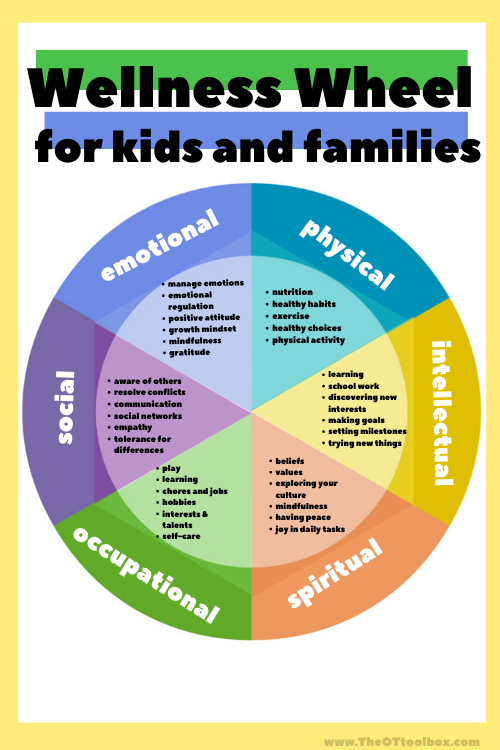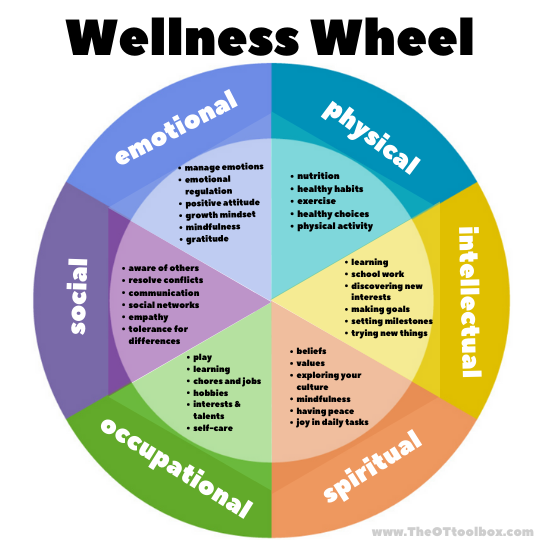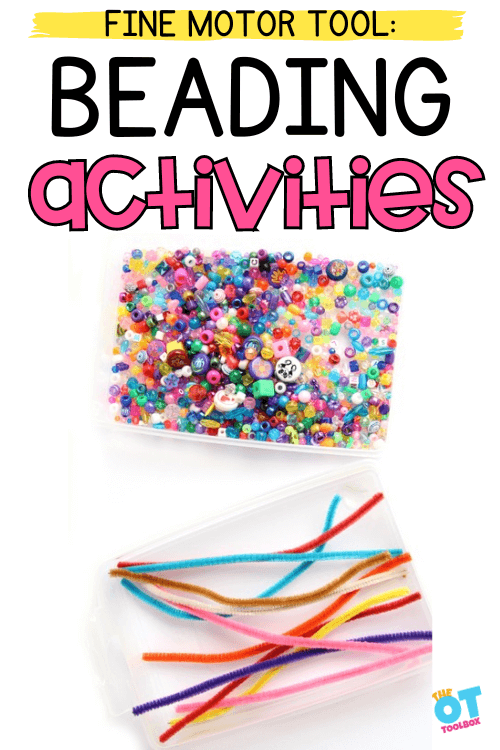You may have seen a “wellness wheel” before. This graphic is a description of all of the wellness concepts that make up the components of a well-balanced lifestyle. While there are different versions of a wellness wheel, and some illustrations that have differing number of wellness components, the wheel imagery is powerful. Check out our Wellness Challenge for ways to encourage wellness for kids and families using all aspects of well-being. A wellness wheel can be pivotal in defining needs and areas of strength that can be addressed through holistic well being strategies.
The graphic of the wheel shows the balance and integration that occurs among all of the wellness components. Each pie piece is important and works together to create an integrated and well-balanced lifestyle.

Wellness Wheel
Each person’s personal wellness wheel will look different. Each individual has their own interests, strengths, needs, occupations, background experiences, etc. Each lifestyle is intrinsically different. One child may have an occupation component that requires participation in a specific sport and the required practices and participation. Another individual may have a heavier component of spiritual impact. Another may have a job that requires performance participation.
While every single individual will view the wheel as an individualized graphic of the life they live, the “spokes” or pie sections of the wellness chart integrate to allow for a healthy and balanced life.
What is a wellness wheel?
A wellness wheel is a visual that helps identify aspects of wellbeing. The representation indicates all of the subcategories of wellness that contribute to your overall well-being. When one of these categories is off-balance, you may sense or feel that your health is “off”. You may notice that you are simply not thriving in various daily tasks, or occupations.
A wellness wheel is a tool to self-analyze personal wellness.
When the wheel is off balanced, you can lack balance in life. Stress can be overwhelming. Productivity lacks. Performance of daily tasks is “off”.
It’s possible to look at the wellness wheel and identify areas that are lacking or need more nurturing. By identifying areas of need and areas where you are overwhelmed, you can make necessary changes.
The wellness wheel is a tool to help one become more aware of the various factors that influence overall well being. It’s a means to make positive changes that contribute to functioning, and quality of life. By being aware of these different facets of a balanced life, it’s possible to let go of the things that are out of your control and foster more focus on areas that are under your control, including choices, actions, thoughts, and emotions.
This wellness wheel was created to cover the family and child, individually or as a whole. You can also adjust this wheel to meet specific occupations such as in the classroom or clinic. You can see the individual components described in the wellness wheel below. The concepts that we will discuss in our wellness challenge include concepts of well being in emotional, spiritual, physical, social, intellectual, and occupational forms.

How to use a wellness wheel
Consider the following subcategories on the wellness wheel: Emotional, Physical, Intellectual, Spiritual, Occupational, and Social. The goal is to take an inventroy of overall wellbeing to see where areas of imbalance may lie. You can use the wellness wheel to identify areas that are off-balance or are bigger or smaller than onther pie piece on the wheel.
If you imagine the wheel as a rolling wheel, would it be a round circle? Or would it be off-centered and roll off to the side? You want to see balance in the pie pieces so the wheel would roll smoothly.
Ask yourself these questions based on the wellness wheel
Ask yourself the following questions on how you are managing various aspects of your overall life:
1. Does any one of these areas impact your stress? Your health? Your performance of tasks?
2. Are there any spokes of the wellness wheel that are off-balance? Are they bigger than another spoke, causing the wheel to shift off-center?
3. Is it possible to adjust to make positive changes in those areas that are off-balance?
4. How can you address the things that you CAN change?
5. Is it possible to let go of the areas where you CAN NOT make changes because they are out of your control?
6. What improvements would you like to see in obtaining a balanced wheel?
Emotional Well being on the Wellness Wheel
- manage emotions
- emotional regulation
- positive attitude
- growth mindset
- mindfulness
- gratitude
Spiritual Well being on the wellness wheel
- beliefs
- values
- exploring your culture
- mindfulness
- having peace
- joy in daily tasks
Physical Well being on the wellness wheel
- nutrition
- healthy habits
- exercise
- healthy choices
- physical activity
Social Well being on the wellness wheel
- aware of others
- resolve conflicts
- communication
- social networks
- empathy
- tolerance for differences
Intellectual Well being on the wellness wheel
- learning
- school work
- discovering new interests
- making goals
- setting milestones
- trying new things
Occupational Well being on the wellness wheel
- play
- learning
- chores and jobs
- hobbies
- interests & talents
- self-care
Other wellness wheels can include aspects of financial well being, environmental well being, nutritional well being.

Colleen Beck, OTR/L has been an occupational therapist since 2000, working in school-based, hand therapy, outpatient peds, EI, and SNF. Colleen created The OT Toolbox to inspire therapists, teachers, and parents with easy and fun tools to help children thrive. Read her story about going from an OT making $3/hour (after paying for kids’ childcare) to a full-time OT resource creator for millions of readers. Want to collaborate? Send an email to contact@theottoolbox.com.


